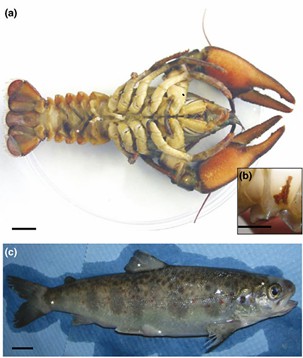Oomycete, also known as water molds, is an umbrella term for many living organisms. They are defined as a distinct fungal-like eukaryotic microbial phylogenetic lineage, and they have a preference for conditions of high humidity. Oomycetes share many characteristics with true fungi. They have similar filamentous, branched, amorphous bodies, and they obtain nutrition by secreting digestive enzymes and then absorbing the breakdown products. Compared with other microbes, fungi and oomycetes are able to damage the epidermis of host plants and establish infection in a short time. Therefore, both are pathogens associated with plant diseases causing significant economic losses.
Characteristics
Oomycetes have many characteristics compared to fungi. Septa in oomycetes are rare, leading to the appearance of multinuclei. Furthermore, the nuclei of vegetative cells are usually diploid. The cell wall consists of glucan instead of chitin. One of the most distinctive features is the production of zoospores within the structure of the sporangia. Although without walls, zoospores maintain a specific shape. Zoospores can swim in a variety of environments, such as natural water bodies and water films on leaf surfaces.
Mode of Multiply
Oomycetes can proliferate sexually as well as asexually. Sexual reproduction involves the contact of the hyphae of the male anther sacs with the female oogonia. Asexual reproduction is closely related to zoospores. Some of them produce sexual spores, which are translucent double-walled spherical structures that can survive some adverse conditions. Most of them produce zoospores that are able to gravitate toward or away from specific chemical signals in surface waters. Some oomycetes produce aerial asexual spores, which are spread by means of the wind.
Pathogenicity
Oomycetes cause severe disease in plants as well as animals. Many oomycete species can lead to fish disease, and at least one is a mammalian pathogen. Additionally, they cause plant diseases that affect ornamental plants and trees. They place a heavy burden on the economy and natural ecosystems.
- Animal pathogenic oomycetes
Pathogenic oomycetes in animals are poorly studied, but they are strongly associated with serious disease outbreaks on farms and in the natural environment. They can infect a wide variety of aquatic and terrestrial animals, from very small microorganisms to insects, amphibians, fish and mammals. Most zoopathogenic oomycetes belong to the subclass Saprolegnia.
 Fig.1 Disease cycle of Peronophythora litchii on host plant.1
Fig.1 Disease cycle of Peronophythora litchii on host plant.1
- Plant pathogenic oomycetes
Oomycetes are one of the most common pathogenic biotas in agriculture, posing a serious threat to global food security. Several pathogens can cause severe diseases, such as late blight of potatoes and sudden death of oak trees. Furthermore, phytopathogenic oomycetes cause devastating diseases in many crops and native plants, which cause severe damage to natural ecosystems.
what can we do?
At Creative Biolabs, our hybridoma and phage display technologies allow the production of highly specific monoclonal antibodies (mAbs) or single-chain Ab variable fragments (scFvs). These Abs can distinguish not only biota but also pathogenic fungi of different genera and species, and thus play a crucial role in the detection of oomycete pathogens. Accumulating evidence indicates that our mAbs have great potential in the development of rapid and specific tests for the diagnosis of human mycosis. If you are interested in our anti-oomycete Abs, please feel free to contact us.
More information can be obtained by clicking on the following link:
Reference
- Situ, Junjian, et al. "Signal and regulatory mechanisms involved in spore development of Phytophthora and Peronophythora." Frontiers in microbiology 13 (2022): 984672. Distributed under Open Access license CC By 4.0, without modification.
-
-
AibGenesis™ Anti-P. infestans Monoclonal Antibody (Mouse mAb) (CAT#: MAS-0524-YJ22)
- Host: Mouse
- Reactivity: P. infestans
- Applications: IF; WB; ELISA
- Conjugations: Conjugation could be customized
-
For Research Use Only. Do NOT use in humans or animals.